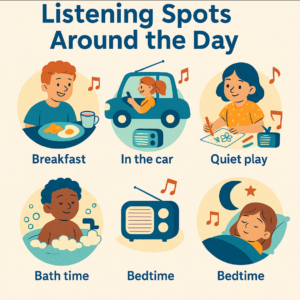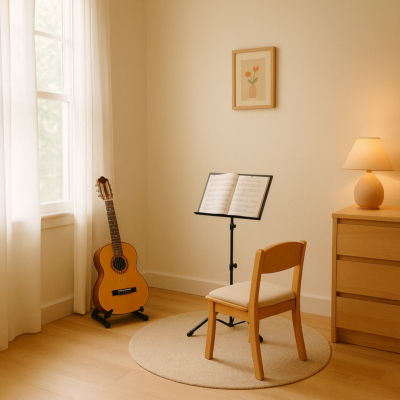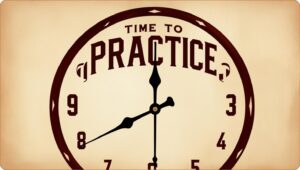Getting your child to practice is one of the biggest challenges for Suzuki parents—but you’re not in it alone. In this blog series, we’ll look at practical ways to make home practice easier, more productive, and yes, even fun!
Our first step in this journey is learning how to set up the environment to support your goals. One of my music education professors used to say, “We control the environment, which in turn controls us.” You have the power to shape the space where practice happens, and thoughtful choices about that space can make a big difference in your child’s focus, motivation, and success.
Here are some of the most important aspects of a good home practice environment:
Play the CD Every Day
Listening is one of the most important parts of the Suzuki method—some would even say the most important. Daily listening helps children internalize the music, learn faster, and stay motivated. You’ll likely notice that when listening is consistent, practice goes more smoothly.
I’ll go into more detail about listening and share specific listening activities in the next post, but for now, the goal is simple: make the CD (or playlist) part of your family’s daily routine—whether it’s during breakfast, on the way to school, or while winding down in the evening.

Designate A Clean, Quiet Space To Practice
Having a regular practice spot makes it easier to build a routine. It doesn’t have to be the only place you ever practice, but having one go-to area helps your child know, “This is where we focus and make music.”
Choose a space that’s clean, quiet, and free from distractions. Avoid areas with lots of foot traffic, toys, or clutter. Good lighting is also important—your child should be able to see their hands and music clearly. Ideally, this is a place where only practice and similar calm activities happen.

Keep The Guitar And Materials Set Up, If Possible
Out of sight, out of mind. Just like setting out gym clothes makes it easier to go to the gym, having the guitar visible and ready to go makes practice more likely to happen.
If it’s safe to do so, keep the guitar out of its case and set up in your practice space. You can also keep the stool, notebook, tuner, and any practice games in the same spot. Having everything ready removes small obstacles that can become big reasons not to practice.
If you have younger children who might knock the guitar over, it’s safer to keep it in the case or on a wall mount.
Also, if your house tends to be very dry (especially in winter), keeping the guitar in its case with a humidifier might be the better option to protect it.

Practice At The Same Time Every Day
Children thrive on routine. Practicing at the same time each day helps make it a normal part of your family’s rhythm. The more consistent you are, the less you’ll have to remind (or convince) your child—it just becomes “what we do.”
You can anchor practice to a fixed time (like 5:00 pm) or tie it to a daily activity (“after we get home from school” or “right after dinner”). Many families find success by connecting the new habit of practicing to something that’s already well established, like brushing teeth or reading before bed.
Finding the right time often takes a little trial and error, and that’s okay. I work with students and parents to build a routine that feels natural and sustainable for their family.